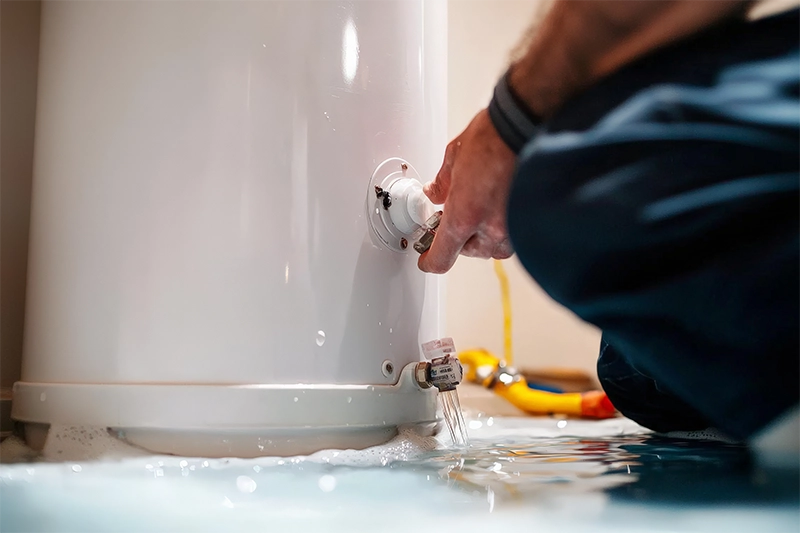A water heater pressure relief valve leaking can be a concerning issue for homeowners in Snellville, GA. Not only does it waste water, but it can also signal underlying problems with your water heater. At True Blue Plumbing, we understand how essential a properly functioning water heater is for your daily comfort. In this guide, we’ll discuss the common causes of a leaking pressure relief valve, how to fix it, and when to call in a professional.
What Is a Water Heater Pressure Relief Valve?
The water heater pressure relief valve (also known as the T&P valve) is a crucial safety component. It helps regulate pressure within the water heater by releasing excess water if the pressure or temperature exceeds safe limits. Without it, excessive pressure could lead to serious damage, including an explosion.
If you notice your water heater pressure relief valve leaking, it’s important to address the issue promptly. But first, let’s explore why it happens.
Common Causes of a Water Heater Pressure Relief Valve Leaking
There are several reasons why your water heater’s relief valve may start leaking. Understanding these causes can help you determine whether a simple fix is needed or if professional plumbing services are required.
1. Excessive Pressure Inside the Water Heater
One of the most common reasons for a water heater pressure relief valve leaking is excessive internal pressure. If the pressure inside your water heater tank becomes too high, the relief valve will open to release some water and reduce pressure. This could be due to:
- High water pressure from your main supply
- A malfunctioning pressure regulator
- Thermal expansion from heating water
2. High Water Temperature
Another possible cause is overheating. If the thermostat is set too high or the unit is malfunctioning, the water inside the tank may reach dangerous temperatures. When this happens, the relief valve releases water to prevent excessive pressure buildup.
3. Faulty or Worn-Out Valve
Over time, the T&P valve itself may wear out, causing it to leak even when the pressure and temperature are within normal ranges. Minerals, debris, and corrosion can affect its ability to seal properly.
4. Sediment Buildup in the Tank
If sediment accumulates in the bottom of your water heater, it can cause overheating and pressure fluctuations. This extra stress may force the relief valve to leak.
5. Improper Installation
If the pressure relief valve was not installed correctly, it may leak prematurely. A valve that is the wrong size or improperly fitted can result in constant dripping.
How to Fix a Water Heater Pressure Relief Valve Leaking Issue
Now that you know the common causes, let’s discuss possible solutions. In some cases, a DIY approach may be enough, while in others, you may need professional assistance from True Blue Plumbing.
1. Check the Temperature and Pressure Settings
Start by checking your water heater’s thermostat. The recommended setting is around 120°F. If it’s set too high, lower it and observe if the leaking stops.
Next, check your home’s water pressure. If it exceeds 80 PSI, installing a pressure-reducing valve may help prevent future leaks.
2. Test the T&P Valve
To test the valve, lift the lever and allow some water to flow out. If it continues to drip after releasing the lever, the valve may be faulty and need replacement.
3. Flush the Water Heater Tank
Draining and flushing your water heater at least once a year can help prevent sediment buildup. Turn off the power supply (or gas) and connect a hose to the drain valve to flush out debris.
4. Replace the Pressure Relief Valve
If the valve itself is faulty, it will need to be replaced. To do this:
- Turn off the water heater and let it cool down.
- Shut off the water supply.
- Remove the old valve using a wrench.
- Install a new T&P valve and secure it tightly.
If you’re unsure about replacing it yourself, our expert plumbers at True Blue Plumbing are here to help.
5. Call a Professional Plumber
If your water heater pressure relief valve leaking issue persists after trying the above solutions, it’s best to call a professional. A licensed plumber can inspect your system for deeper issues like faulty thermostats, excessive pressure, or water heater failure.
When to Replace Your Water Heater
Sometimes, a leaking relief valve is a sign of a bigger problem. If your water heater is over 10-15 years old, constantly leaking, or experiencing other issues like rust or inconsistent hot water, it may be time for a replacement.
At True Blue Plumbing, we offer expert water heater services, including repair, maintenance, and installation in Snellville, GA. If your unit is outdated or beyond repair, we can help you choose a new, energy-efficient model.
Preventing Future Water Heater Pressure Relief Valve Leaking
Preventative maintenance can help extend the life of your water heater and prevent future leaks. Here are some tips:
- Schedule annual water heater inspections.
- Flush your tank regularly to remove sediment.
- Monitor pressure and temperature settings.
- Replace worn-out components promptly.
Contact Us For Water Heater Pressure Relief Valve Leaking Repair
If you’re dealing with a water heater pressure relief valve leaking in Snellville, GA, don’t wait until it turns into a bigger problem. True Blue Plumbing provides reliable and efficient water heater repair and replacement services. Our experienced team can diagnose and fix the issue quickly to ensure your home’s plumbing system remains in top condition.
Call us today to schedule an appointment or learn more about our water heater services!


